Geological and Mineralogical Mapping Based on Statistical Methods of Remote Sensing Data Processing of Landsat-8: A Case Study in the Southeastern Transbaikalia, Russia
Abstract
:1. Introduction
2. Geological Setting
3. Data and Methodology
3.1. Satellite Optical Data Characteristics
3.2. Pre-Processing of Satellite Optical Data
3.3. Image Processing Techniques
3.4. False Color Composite
3.5. Principal Component Analysis
3.6. Minimum Noise Fraction
3.7. Independent Component Analysis
3.8. Fuzzy Logic Modeling
4. Research Results
4.1. False Color Composite
4.2. Principal Component Method
4.3. Minimum Noise Fraction
4.4. Independent Component Analysis
4.5. Modeling of Prospectivity Map for the Discovery of Minerals
5. Discussion
6. Conclusions
Author Contributions
Funding
Institutional Review Board Statement
Informed Consent Statement
Data Availability Statement
Conflicts of Interest
References
- Kirsanov, A.A.; Lipiyainen, K.L.; Smirnov, M.Y. Identification of areas perspective for gold mineralization based on results of aeroborne and satellite hyperspectral data processing. Reg. Geol. Metallog. 2019, 78, 82–90. [Google Scholar]
- Smirnova, I.O.; Kirsanov, A.A.; Kamyshnikova, N.V. A review of the past 5 years of international advances in multi- and hyperspectral satellite data application and processing techniques in geological research. Mod. Probl. Remote Sens. Earth Space 2020, 17, 9–27. [Google Scholar] [CrossRef]
- Sakhnovsky, M.L.; Borozdin, A.P.; Vinogradov, L.A. Guidelines for Organizing and Evaluating Geological and Mineralogical Mapping at Scales of 1:500,000 and 1:200,000; Map Manufactory VSEGEI: St. Petersburg, Russia, 2009; 280p, ISBN 978-5-93761-148-2.
- Sakhnovsky, M.L.; Bondarenko, V.M.; Golovin, A.A. Requirements for the Organization and Conduct of Geological and Mineralogical Mapping at Scales of 1:500,000 and 1:200,000; Map manufactory VSEGEI: St. Petersburg, Russia, 2009; 88p, ISBN 978-5-93761-136-9.
- Eldosouky, A.M.; Sehsah, H.; Elkhateeb, S.O.; Pour, A.B. Integrating aeromagnetic data and Landsat-8 imagery for detection of post-accretionary shear zones controlling hydrothermal alterations: The Allaqi-Heiani Suture zone, South Eastern Desert, Egypt. Adv. Space Res. 2019, 65, 1008–1024. [Google Scholar] [CrossRef]
- Sheikhrahimi, A.; Pour, A.B.; Pradhan, B.; Zoheir, B. Mapping hydrothermal alteration zones and lineaments associated with orogenic gold mineralization using ASTER data: A case study from the Sanandaj-Sirjan Zone, Iran. Adv. Space Res. 2019, 63, 3315–3332. [Google Scholar] [CrossRef]
- Zoheir, B.; El-Wahed, M.A.; Pour, A.B.; Abdelnasser, A. Orogenic Gold in Transpression and Transtension Zones: Field and Remote Sensing Studies of the Barramiya-Mueilha Sector, Egypt. Remote Sens. 2019, 11, 2122. [Google Scholar] [CrossRef] [Green Version]
- Noori, L.; Pour, B.A.; Askari, G.; Taghipour, N.; Pradhan, B.; Lee, C.-W.; Honarmand, M. Comparison of Different Algorithms to Map Hydrothermal Alteration Zones Using ASTER Remote Sensing Data for Polymetallic Vein-Type Ore Exploration: Toroud-Chahshirin Magmatic Belt (TCMB), North Iran. Remote Sens. 2019, 11, 495. [Google Scholar] [CrossRef] [Green Version]
- Pour, B.A.; Hashim, M. The application of ASTER remote sensing data to porphyry copper and epithermal gold deposits. Ore Geol. Rev. 2016, 44, 1–9. [Google Scholar] [CrossRef] [Green Version]
- Pour, A.B.; Hashim, M.; Park, Y.; Hong, J.K. Mapping alteration mineral zones and lithological units in Antarctic regions using spectral bands of ASTER remote sensing data. Geocarto Int. 2018, 33, 1281–1306. [Google Scholar] [CrossRef]
- Pour, A.B.; Park, Y.; Park, T.S.; Hong, J.K.; Hashim, M.; Woo, J.; Ayoobi, I. Regional geology mapping using satellite-based remote sensing approach in Northern Victoria Land, Antarctica. Polar Sci. 2018, 16, 23–46. [Google Scholar] [CrossRef]
- Pour, A.B.; Park, T.S.; Park, Y.; Hong, J.K.; Zoheir, B.; Pradhan, B.; Ayoobi, I.; Hashim, M. Application of multi-sensor satellite data for exploration of Zn-Pb sulfide mineralization in the Franklinian Basin, North Greenland. Remote Sens. 2018, 10, 1186. [Google Scholar] [CrossRef] [Green Version]
- Pour, B.A.; Hashim, M.; Marghany, M. Exploration of gold mineralization in a tropical region using Earth Observing-1 (EO1) and JERS-1 SAR data: A case study from Bau gold field, Sarawak, Malaysia. Arab. J. Geosci. 2014, 7, 2393–2406. [Google Scholar] [CrossRef]
- Deller, M.E.A. Facies discrimination in laterites using Landsat Thematic Mapper, ASTER and AlI data—Example from Eritrea and Arabia. Int. J. Remote Sens. 2006, 27, 2389–2409. [Google Scholar] [CrossRef]
- Pour, B.A.; Hashim, M.; van Genderen, J. Detection of hydrothermal alteration zones in a tropical region using satellite remote sensing data: Bau gold field, Sarawak, Malaysia. Ore Geol. Rev. 2013, 54, 181–196. [Google Scholar] [CrossRef]
- Wambo, J.D.T.; Pour, A.B.; Ganno, S.; Asimow, P.D.; Zoheir, B.; dos Reis Salles, R.; Nzenti, J.P.; Pradhan, B.; Muslim, A.M. Identifying high potential zones of gold mineralization in a sub-tropical region using Landsat-8 and ASTER remote sensing data: A case study of the Ngoura-Colomines goldfield, eastern Cameroon. Ore Geol. Rev. 2020, 122, 103530. [Google Scholar] [CrossRef]
- Carranza, E.J.M.; Hale, M. Mineral imaging with Landsat Thematic Mapper data for hydrothermal alteration mapping in heavily vegetated terrane. Int. J. Remote Sens. 2010, 23, 4827–4852. [Google Scholar] [CrossRef]
- Rajendran, S.; Nasir, S. ASTER capability in mapping of mineral resources of arid region: A review on mapping of mineral resources of the Sultanate of Oman. Ore Geol. Rev. 2019, 108, 33–53. [Google Scholar] [CrossRef]
- Ihlen, V.; Zanter, K. Landsat 8 (L8) Data Users Handbook; Report of the Geological Survey of the USGS; USGS: Reston, VA, USA, 2019; 114p.
- Richards, J.A.; Xiuping, J. Remote Sensing Digital Image Analysis: An Introduction; Springer Nature: Berlin, Germany, 2006; 440p, ISBN 9783540251286. [Google Scholar]
- Ruiz-Armenta, J.R.; Prol-Ledesma, R.M. Techniques for enhancing the spectral response of hydrothermal alteration minerals in Thematic Mapper images of Central Mexico. Int. J. Remote Sens. 1998, 19, 1981–2000. [Google Scholar] [CrossRef]
- Green, A.A.; Berman, M.; Craig, M.D. A Transformation for ordering multispectral data in terms of image quality with implications for noise removal. IEEE Trans. Geosci. Remote Sens. 1988, 26, 65–74. [Google Scholar] [CrossRef] [Green Version]
- Comon, P. Independent component analysis, A new concept? Signal Process. Image Commun. 1994, 36, 287–314. [Google Scholar] [CrossRef]
- Clark, R.N.; Swayze, G.A. Mapping minerals, amorphous materials, environmental materials, vegetation, water, ice, and snow, and other materials. In Summaries of the Fifth Annual JPL Airborne Earth Science Workshop, The United States Geological Survey; Jet Propulsion Laboratory: Pasadena, CA, USA, 1995; pp. 39–40. [Google Scholar]
- Hunt, G.R.; Ashley, R.P. Spectra of altered rocks in the visible and near-infrared. Econ. Geol. 1979, 74, 1613–1629. [Google Scholar] [CrossRef]
- Zhao, D.; Zhao, X.; Khongnawang, T.; Arshad, M.; Triantafilis, J. A Vis-NIR Spectral Library to Predict Clay in Australian Cotton Growing Soil. Soil Sci. Soc. Am. J. 2018, 82, 1347–1357. [Google Scholar] [CrossRef]
- Novák, V.; Perfilieva, I.; Mockor, J. Mathematical Principles of Fuzzy Logic; Springer Science & Business Media: Berlin/Heidelberg, Germany, 1999; 320p, ISBN 978-0-7923-8595-0. [Google Scholar]
- Novikova, M.S. Economic and Geographical Features of the Development of the South-Eastern Regions of the Trans-Baikal Territory; Academic Publishing House “GEO”: Novosibirsk, Russia, 2014; 162p, ISBN 978-5-906284-42-6. [Google Scholar]
- Ischukova, L.P.; Igoshin, Y.A.; Avdeev, B.V.; Gubkin, G.N.; Filipchenko, Y.A.; Popova, A.I.; Rogova, V.P.; Makushin, M.F.; Khomentovsky, B.N.; Spirin, E.K. Geology of the Urulyunguevsky Ore Region and Molybdenum-Uranium Deposits of the Streltsovsky Ore Field; Geoinformmark: Moskow, Russia, 1998; 329p. [Google Scholar]
- Andreeva, O.V.; Petrov, V.A.; Poluektov, V.V. Mesozoic felsic magmatites of southeastern Transbaikalia: Petrogeochemistry, connection with metasomatism and ore formation. Geol. Ore Depos. 2020, 62, 76–104. [Google Scholar] [CrossRef]
- Petrov, V.A.; Andreeva, O.V.; Poluektov, V.V. Tectonomagmatic cycles and geodynamic settings for the formation of ore-bearing systems in the Southern Argun region. Geol. Ore Depos. 2017, 59, 445–469. [Google Scholar] [CrossRef]
- Shivokhin, E.A.; Ozersky, A.F.; Artamonova, N.A.; Dukhovskiy, A.A.; Karasev, V.V.; Kurylenko, A.V.; Nadezhdina, T.N.; Pavlenko, Y.V.; Raitina, N.I.; Shor, G.M. State Geological Map of the Russian Federation. Scale 1:1,000,000 (Third Generation); Sheet M-50–Greyhound, Explanatory letter; VSEGEI: St. Petersburg, Russia, 2010; 553p. [Google Scholar]
- Irons, J.R.; Dwyer, J.L.; Barsi, J.A. The next Landsat satellite; the Landsat Data Continuity Mission. Remote Sens. Environ. 2012, 122, 11–21. [Google Scholar] [CrossRef] [Green Version]
- Acharya, T.; Yang, I. Exploring Landsat 8. Int. J. IT Eng. Appl. Sci. Res. 2015, 4, 4–10. [Google Scholar]
- Roy, D.P.; Wulder, M.A.; Loveland, T.R.; Woodcock, C.E.; Allen, R.G.; Anderson, M.C.; Helder, D.; Irons, J.R.; Johnson, D.M.; Kennedy, R.; et al. Landsat-8: Science and product vision for terrestrial global change research. Remote Sens. Environ. 2014, 145, 154–172. [Google Scholar] [CrossRef] [Green Version]
- Cooley, T.; Anderson, G.P.; Felde, G.W.; Hoke, M.L.; Ratkowski, A.J.; Chetwynd, J.H.; Gardner, J.A.; Adler-Golden, S.M.; Matthew, M.W.; Berk, A.; et al. FLAASH, a MODTRAN4-based atmospheric correction algorithm, its application and validation. Int. Geosci. Remote Sens. Symp. 2002, 3, 1414–1418. [Google Scholar] [CrossRef]
- Research Systems, Inc. ENVI Tutorials; A rjdak Company, Research Systems, Inc.: Sydney, Australia, 2008; 620p. [Google Scholar]
- Berk, A.; Bernstein, L.S.; Robertson, D.C. MODTRAN: A moderate resolution model for LOWTRAN. 7. U.S.C. Geophys. Lab. Tech. Rep. 1989, 89, 44. [Google Scholar]
- Mather, P.M.; Koch, M. Computer Processing of Remotely Sensed Images. An Introduction; John Wiley and Sons: Hoboken, NJ, USA, 1999; 434p, ISBN 9780470666517. [Google Scholar]
- Kumar, C.; Shetty, A.; Raval, S.; Champatiray, P.K.; Sharma, R. Sub-Pixel mineral mapping using EO-1 Hyperion hyperspectral data. Int. Arch. Photogramm. Remote Sens. Spat. Inf. Sci. 2014, 8, 455–461. [Google Scholar] [CrossRef] [Green Version]
- Kriegler, F.; Malila, W.; Nalepka, R.; Richardson, W. Preprocessing transformations and their effect on multispectral recognition. In Proceedings of the Sixth International Symposium on Remote Sensing of Environment, Ann Arbor, MI, USA, 13–16 October 1969; pp. 97–131. [Google Scholar]
- Gao, B.-C. NDWI—A normalized difference water index for remote sensing of vegetation liquid water from space. Remote Sens. Environ. 1996, 58, 257–266. [Google Scholar] [CrossRef]
- Laben, C.A.; Brower, B.V. Process for Enhancing the Spatial Resolution of Multispectral Imagery Using Pan-Sharpening. U.S. Patent 6.011.875, 4 January 2000. [Google Scholar]
- Mwaniki, M.W.; Matthias, M.S.M.; Schellmann, G. Application of remote sensing technologies to map the structural geology of central Region of Kenya. IEEE J. Sel. Top. Appl. Earth Obs. Remote Sens. 2015, 8, 1855–1867. [Google Scholar] [CrossRef]
- Drury, S.A. Image Interpretation in Geology; Chapman & Hall: London, UK, 2001; 290p, ISBN 978-0748764990. [Google Scholar]
- Chukwu, G.U.; Ijeh, B.I.; Olunwa, K.C. Application of Landsat imagery for landuse/landcover analyses in the Afikpo sub-basin of Nigeria. J. Geol. Min. Res. 2013, 3, 67–81. [Google Scholar]
- Sabins, F.F., Jr.; Ellis, J.M. Remote Sensing: Principles and Applications; Waveland Press: Long Grove, IL, USA, 1997; 524p, ISBN 978-1478637103. [Google Scholar]
- Bishta, A. Lithologic Discrimination Using Selective Image Processing Technique of Landsat 7 Data, Um Bogma Environs Westcentral Sinai, Egypt. J. King Abdulaziz Univ. Mar. Sci. 2009, 20, 193–213. [Google Scholar] [CrossRef]
- Ourhzif, Z.; Algouti, A. Lithological mapping using Landsat 8 OLI and Aster multispectral data in Imini-Ounilla district South high Atlas of Marrakech. Int. Arch. Photogramm. Remote Sens. Spat. Inf. Sci. 2019, XLII-2/W13, 1255–1262. [Google Scholar] [CrossRef] [Green Version]
- Pour, A.B.; Hashim, M. Hydrothermal alteration mapping from Landsat-8 data, Sar Cheshmeh copper mining district, south-eastern Islamic Republic of Iran. J. Taibah Univ. Sci. 2015, 9, 155–166. [Google Scholar] [CrossRef]
- Chang, Q.; Jing, L.; Panahi, A. Principal component analysis with optimum order sample correlation coefficient for image enhancement. Int. J. Remote Sens. 2006, 27, 3387–3401. [Google Scholar] [CrossRef]
- Crosta, A.P.; Moore, J.M. Enhancement of Landsat Thematic Mapper imagery for residual soil mapping in SW Minais Gerais State, Brazil: A prospecting case history in Greenstone belt terrain. In Proceedings of the 7th Thematic Conference on Remote Sensing for Exploration Geology, Calgary, AB, Canada, 2–6 October 1989; pp. 1173–1187. [Google Scholar]
- Kruse, F.A.; Lefkoff, A.B.; Boardman, J.W.; Heidebrecht, K.B.; Shapiro, A.T.; Barloon, P.J.; Goetz, A.F.H. The spectral image processing system (SIPS)—Interactive visualization and analysis of imaging spectrometer data. Remote Sens. Environ. 1993, 44, 145–163. [Google Scholar] [CrossRef]
- Loughlin, W.P. Principal component analysis for alteration mapping. Photogramm. Eng. Remote Sens. 1991, 57, 1163–1169. [Google Scholar]
- Boardman, J.W.; Kruse, F.A. Automated spectral analysis: A geological example using AVIRIS data, north Grapevine Mountains, Nevada. In Proceedings of the 10th Thematic Conference on Geological Remote Sensing, San Antonio, TX, USA, 9–12 May 1994; pp. 407–418. [Google Scholar]
- Amari, S.; Cichocki, A.; Yang, H.H. A new learning algorithm for blind signal separation. Adv. Neural. Inf. Process Syst. 1996, 8, 757–763. [Google Scholar]
- Adiri, Z.; El Harti, A.; Jellouli, A.; Maacha, L.A.; Zouhair, M.; Bachaoui, M. Mineralogical mapping using Landsat-8 OLI, Terra ASTER and Sentinel-2A multispectral data in Sidi Flah Bouskour inlier, Moroccan Anti-Atlas. J. Spat. Sci. 2019, 65, 147–171. [Google Scholar] [CrossRef]
- Kumar, C.; Shetty, A.; Raval, S.; Sharma, R.; Ray, P.K.C. Lithological Discrimination and Mapping using ASTER SWIR Data in the Udaipur area of Rajasthan, India. Procedia Environ. Sci. 2015, 11, 180–188. [Google Scholar] [CrossRef] [Green Version]
- Zadeh, L.A. Fuzzy sets. Inf. Control. 1965, 8, 338–353. [Google Scholar] [CrossRef] [Green Version]
- Ghanbari, Y.; Hezarkhani, A.; Ataei, M.; Pazand, K. Mineral potential mapping with fuzzy models in the Kerman-Kashmar Tectonic Zone, Central Iran. Appl. Geomat. 2012, 4, 173–186. [Google Scholar] [CrossRef]
- Kim, Y.H.; Choe, K.U.; Ri, R.K. Application of fuzzy logic and geometric average: A Cu sulfide deposits potential mapping case study from Kapsan Basin, DPR Korea. Ore Geol. Rev. 2019, 107, 239–247. [Google Scholar] [CrossRef]
- Nykänen, V.; Groves, D.I.; Ojala, V.J.; Eilu, P.; Gardoll, S.J. Reconnaissance-scale conceptual fuzzy-logic prospectivity modelling for iron oxide copper-gold deposits in the northern Fennoscandian Shield, Finland. Aust. J. Earth Sci. 2008, 55, 25–38. [Google Scholar] [CrossRef]
- Carranza, E.J.M. Geochemical Anomaly and Mineral Prospectivity Mapping in GIS; Elsevier: Amsterdam, The Netherlands, 2008; 347p, ISBN 978-0-444-51325-0. [Google Scholar]
- Sekandari, M.; Masoumi, I.; Pour, A.B. Application of Landsat-8, Sentinel-2, ASTER and WorldView-3 Spectral Imagery for Exploration of Carbonate-Hosted Pb-Zn Deposits in the Central Iranian Terrane (CIT). Remote Sens. 2020, 12, 1239. [Google Scholar] [CrossRef] [Green Version]
- Zimmermann, H.-J.; Zysno, P. Latent Connectives in Human Decision Making. Fuzzy Sets Syst. 1980, 4, 37–51. [Google Scholar] [CrossRef]
- An, P.; Moon, W.M.; Rencz, A. Application of fuzzy set theory to integrated mineral exploration. Can. J. Explor. Geophys. 1991, 27, 1–11. [Google Scholar]
- Bonham-Carter, G.F. Geographic Information Systems for Geoscientists: Modeling with GIS; Elsevier: Amsterdam, The Netherlands, 1994; 402p, ISBN 9781483144948. [Google Scholar]
- Carranza, E.J.M.; Hale, M. Geologically constrained fuzzy mapping of gold mineralization potential, Bauio District, Philippines. Nat. Resour. Res. 2001, 10, 125–136. [Google Scholar] [CrossRef]
- Crowley, J.K.; Brickey, D.W.; Rowan, L.C. Airborne imaging spectrometer data of the Ruby Mountains, Montana: Mineral discrimination using relative absorption band-depth images. Remote Sens. Environ. 1989, 29, 121–134. [Google Scholar] [CrossRef]
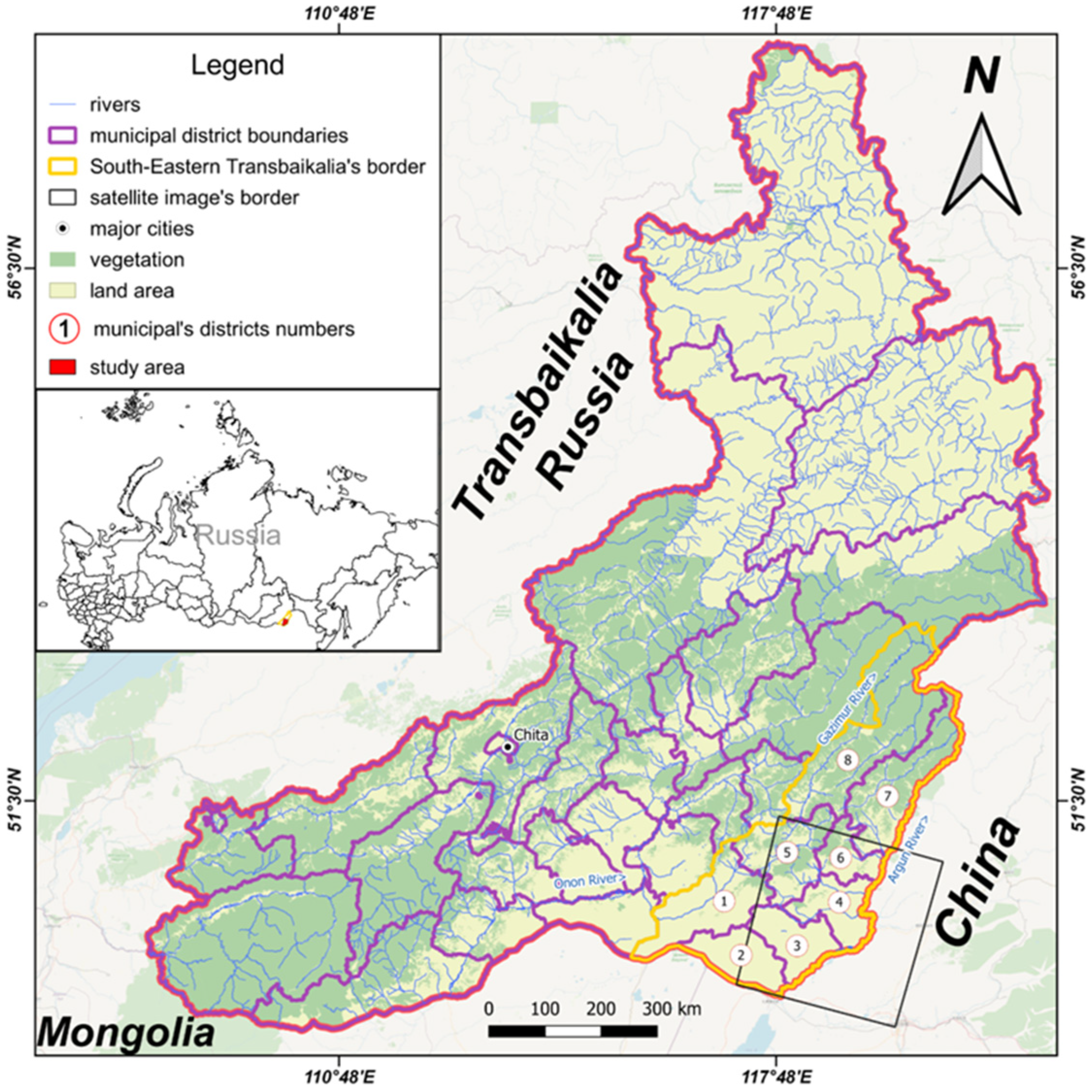
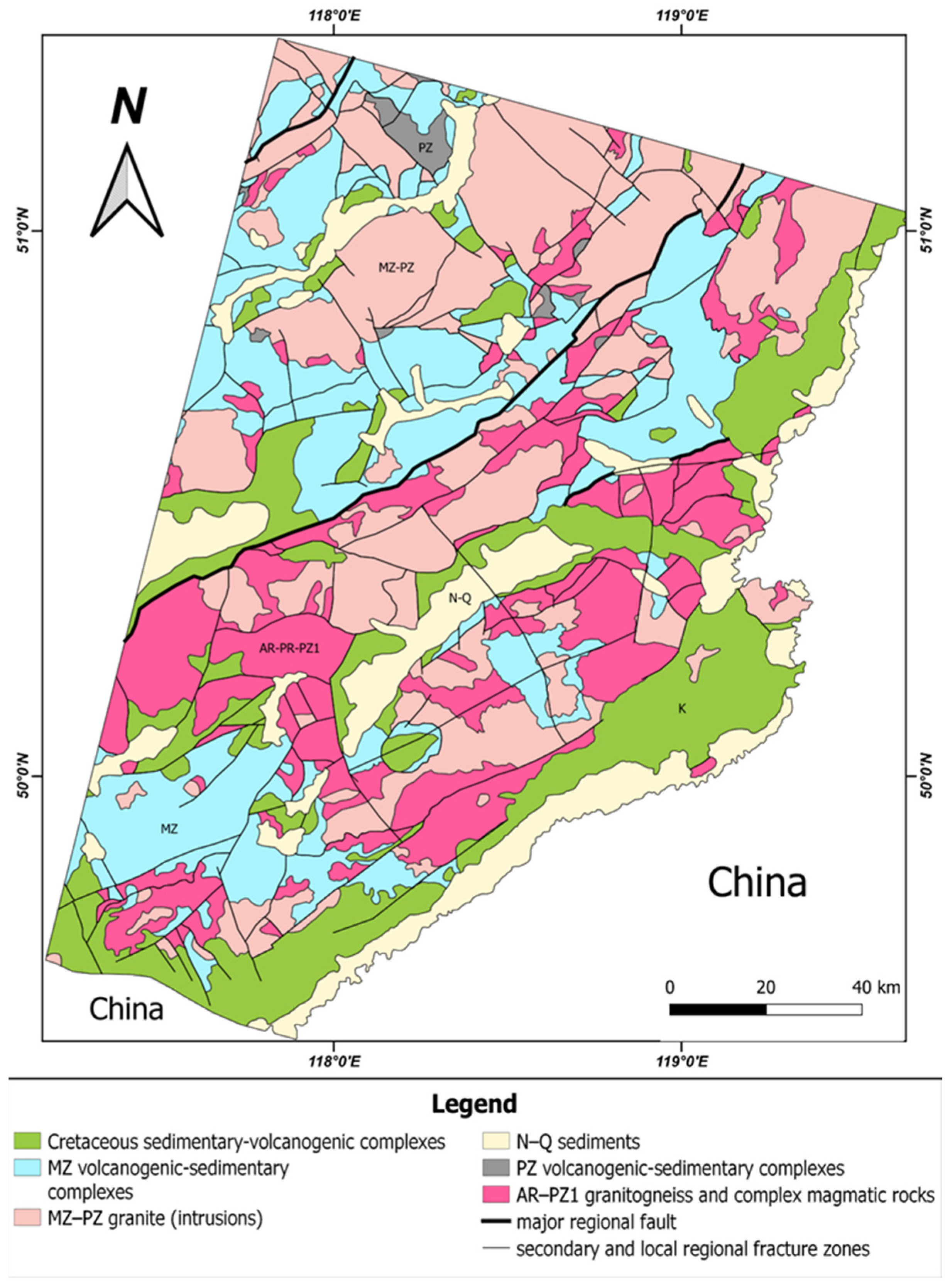
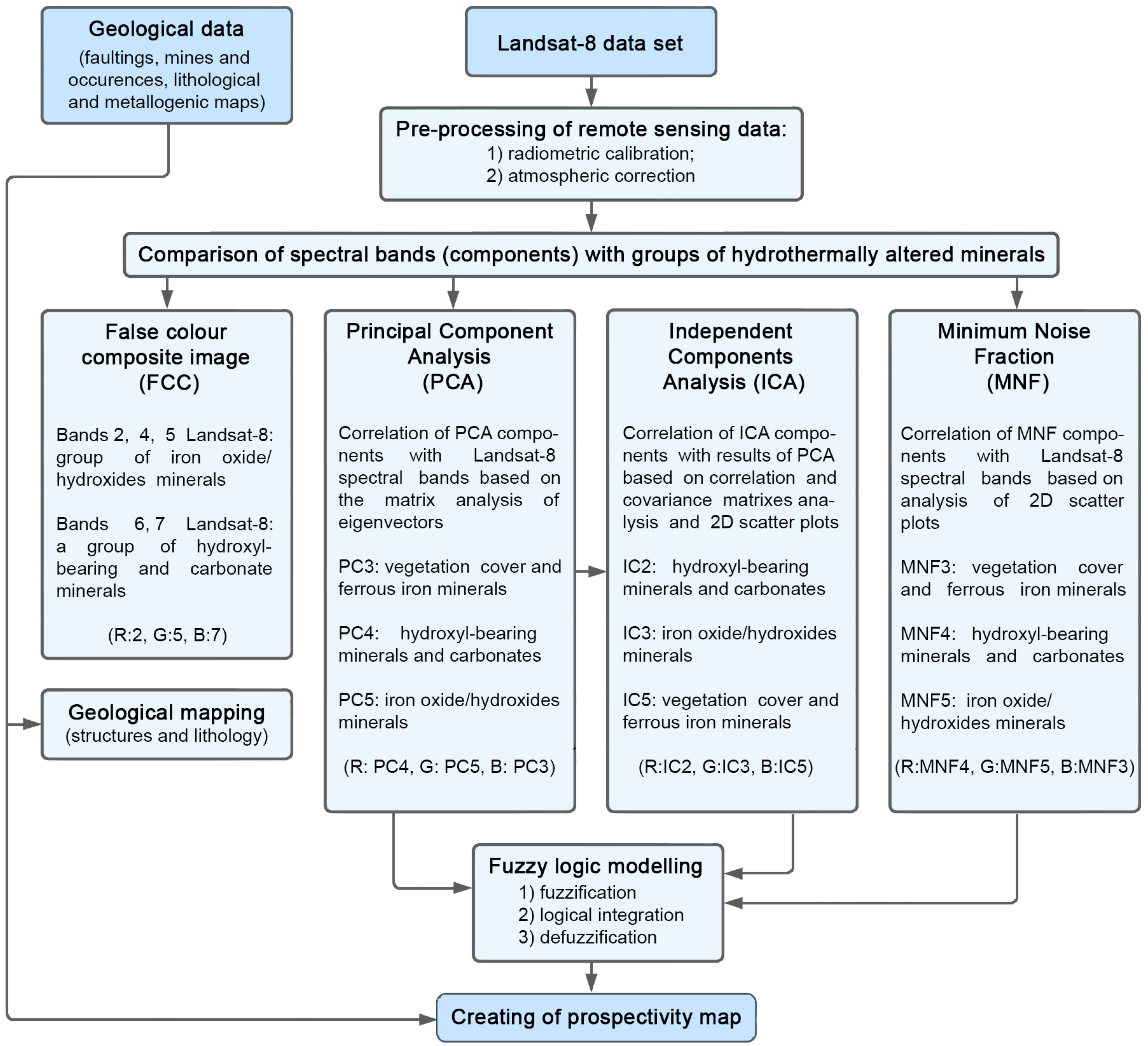
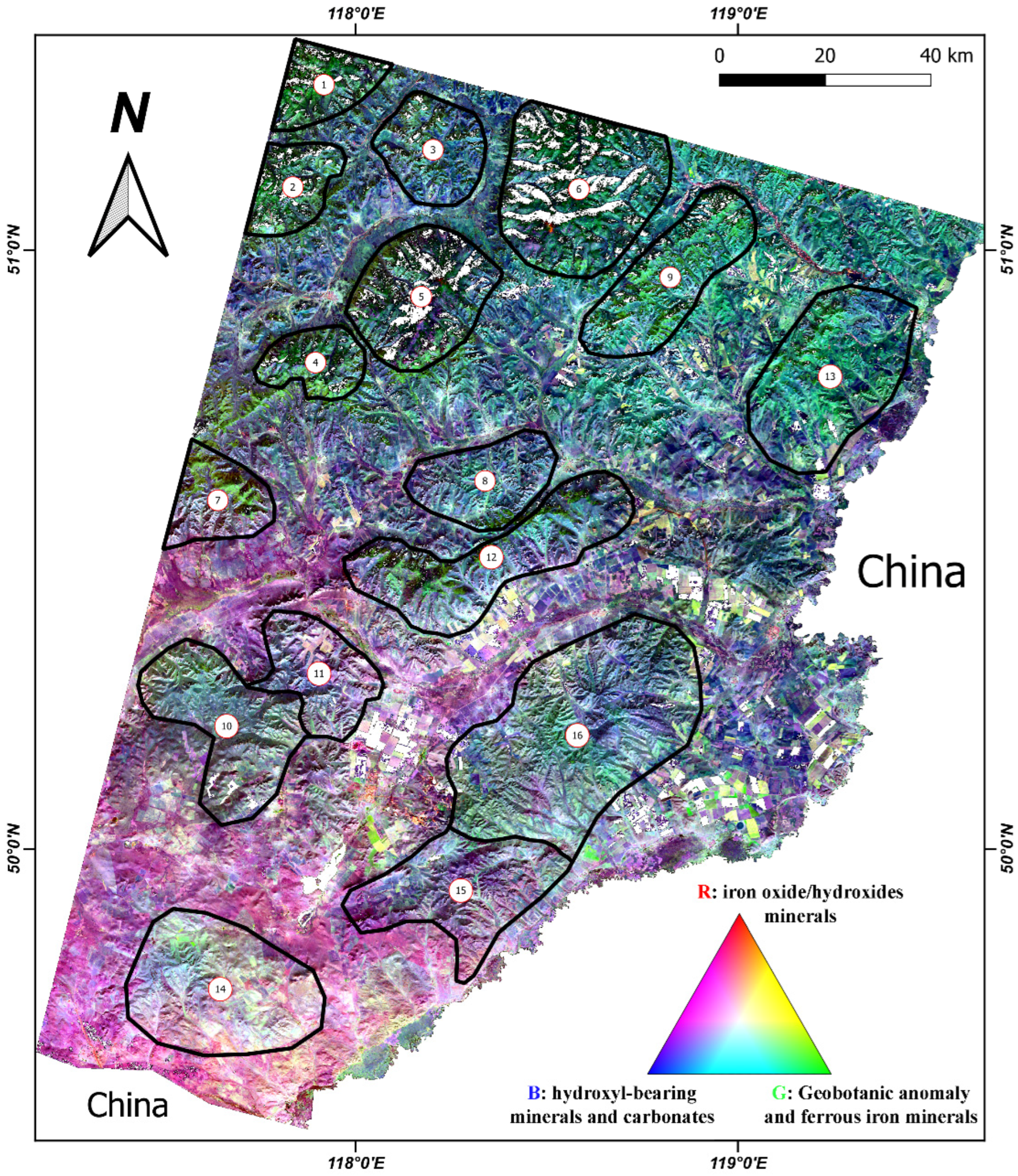
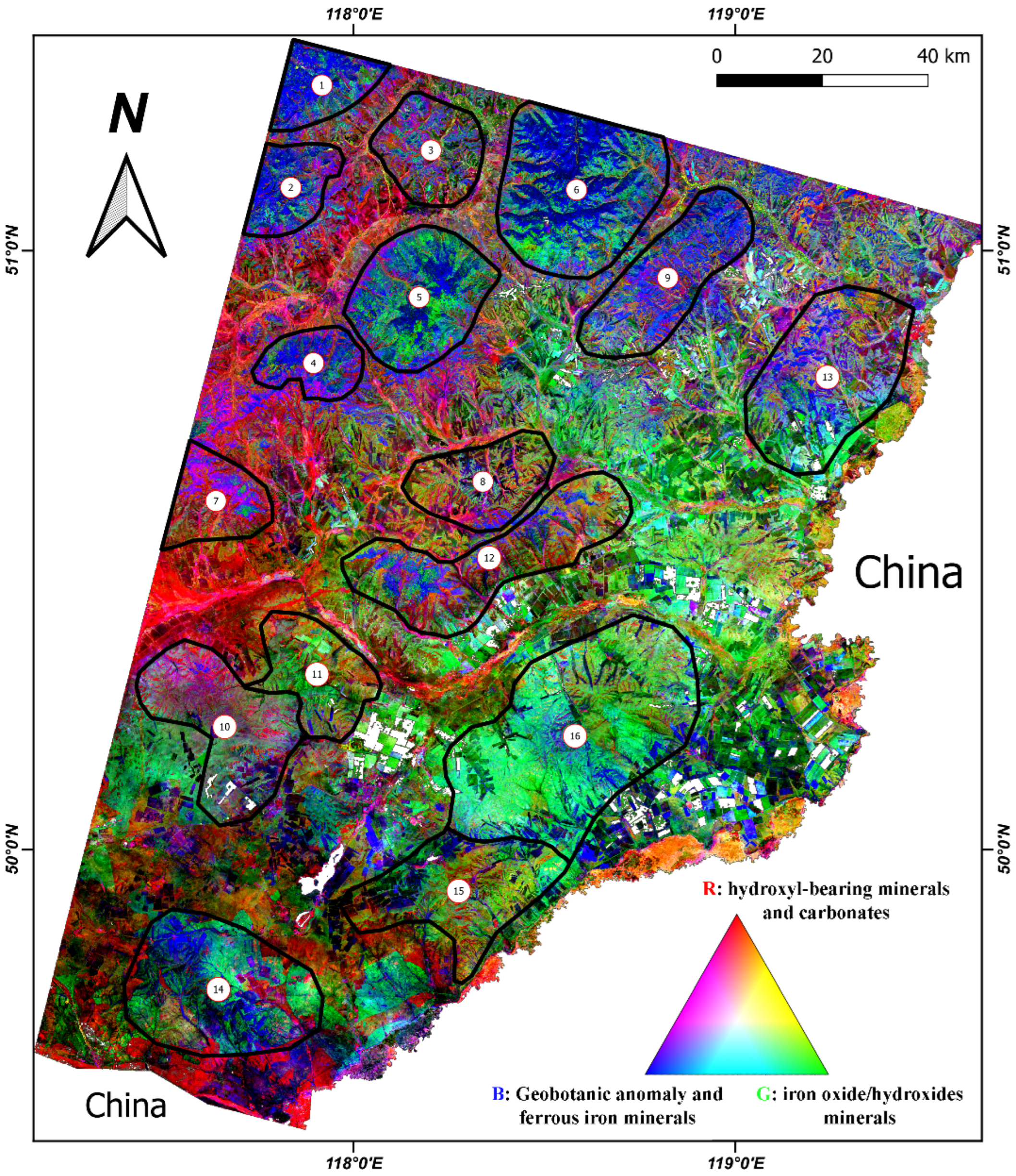
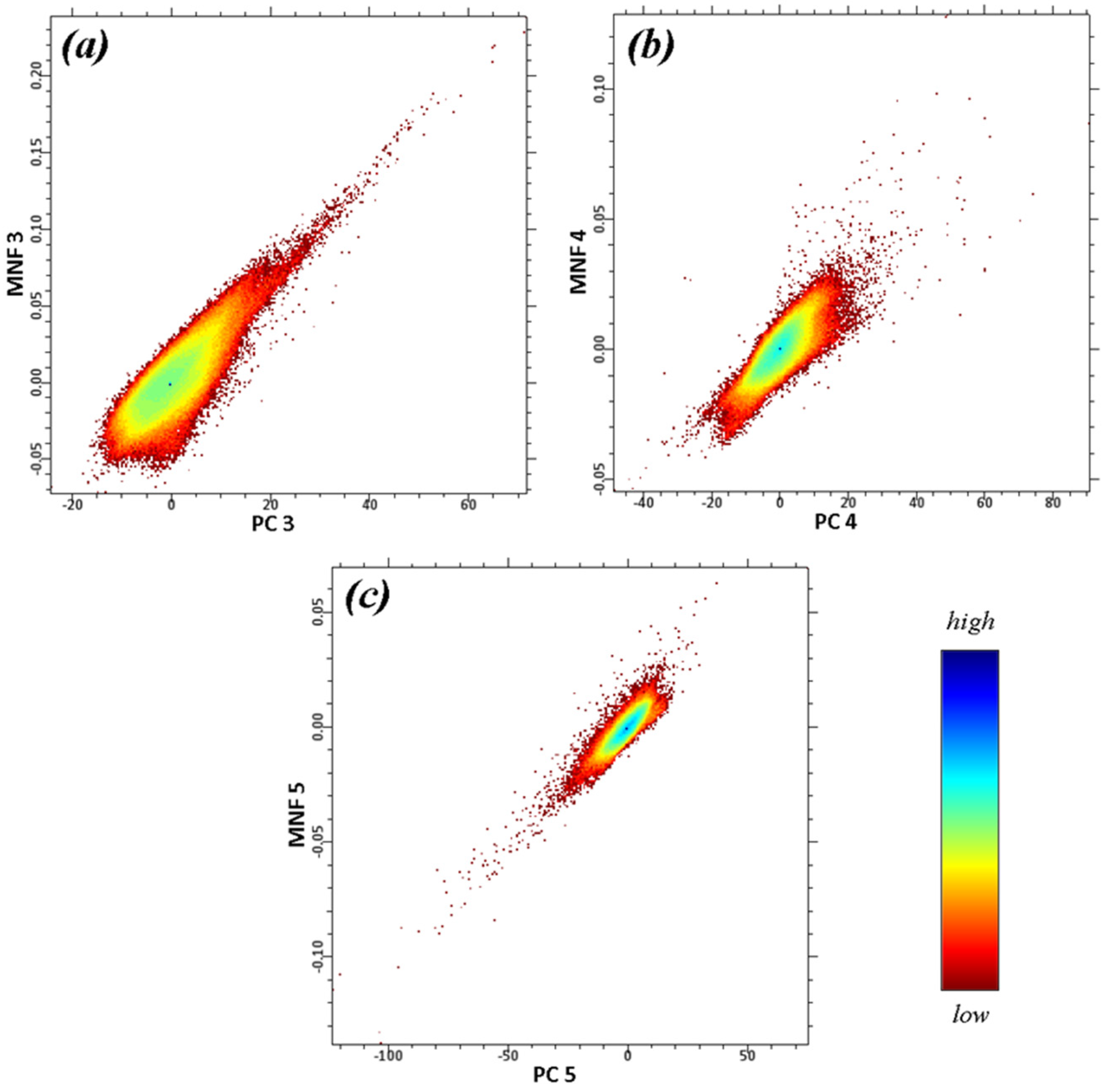
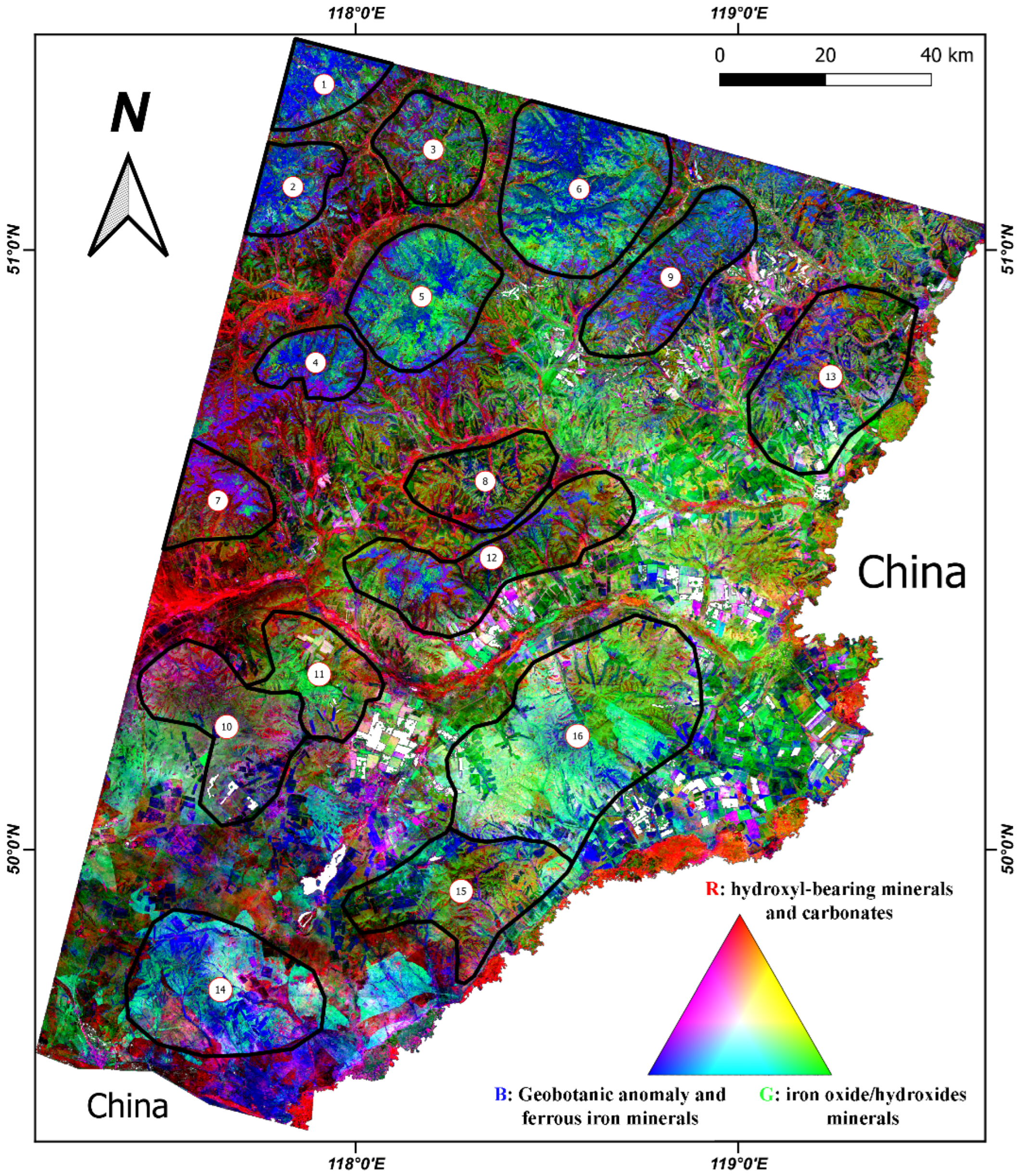
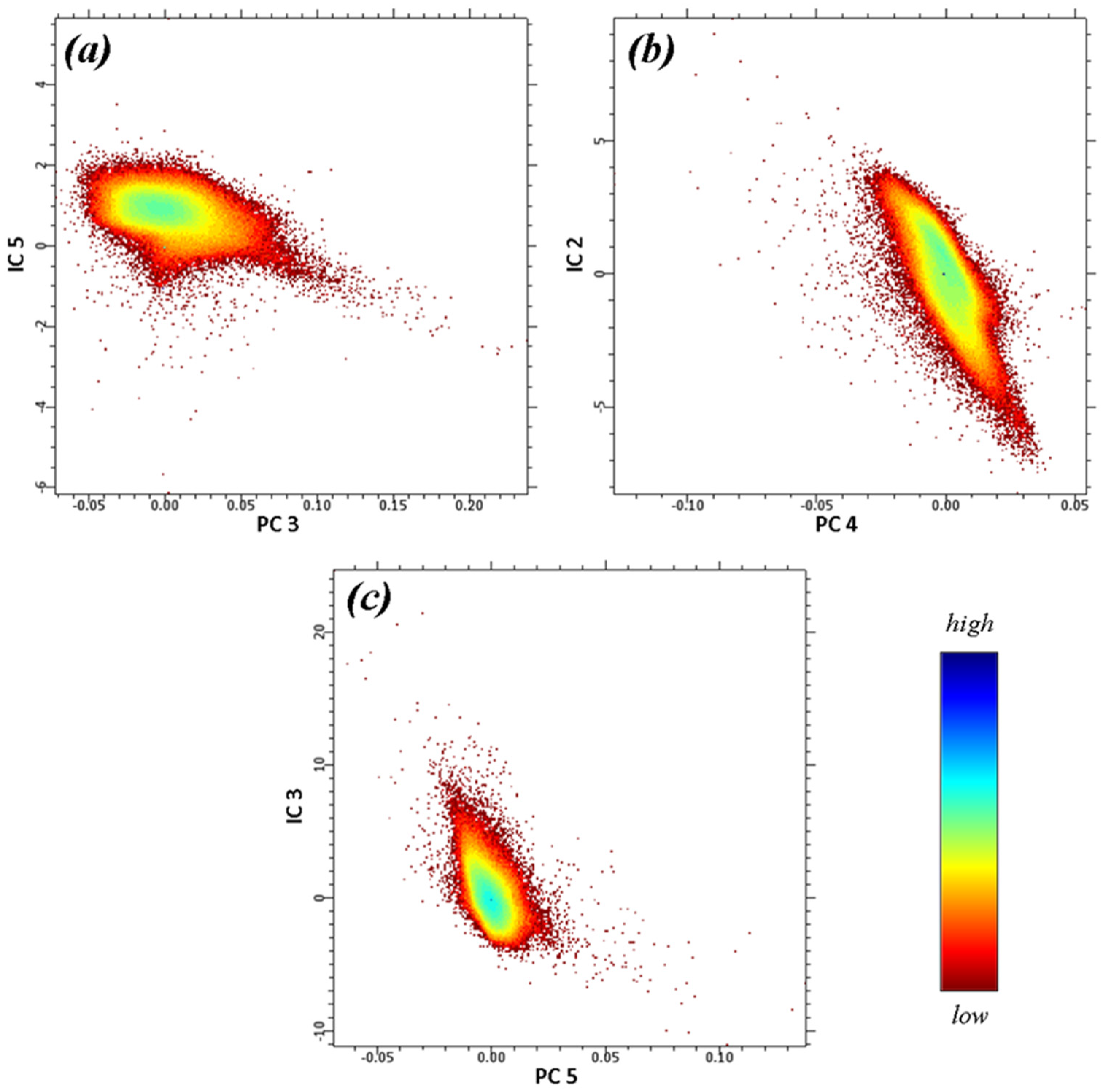
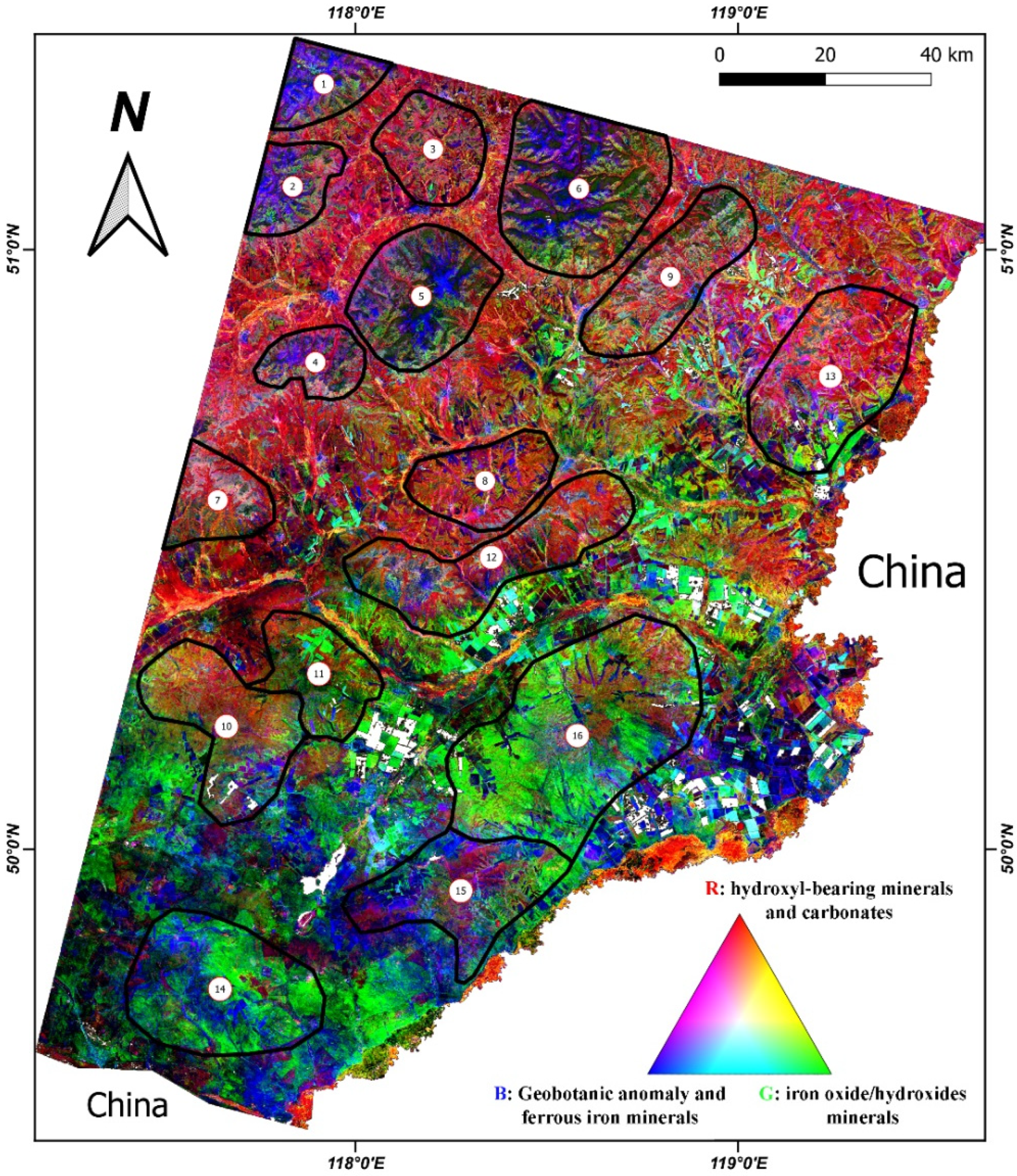
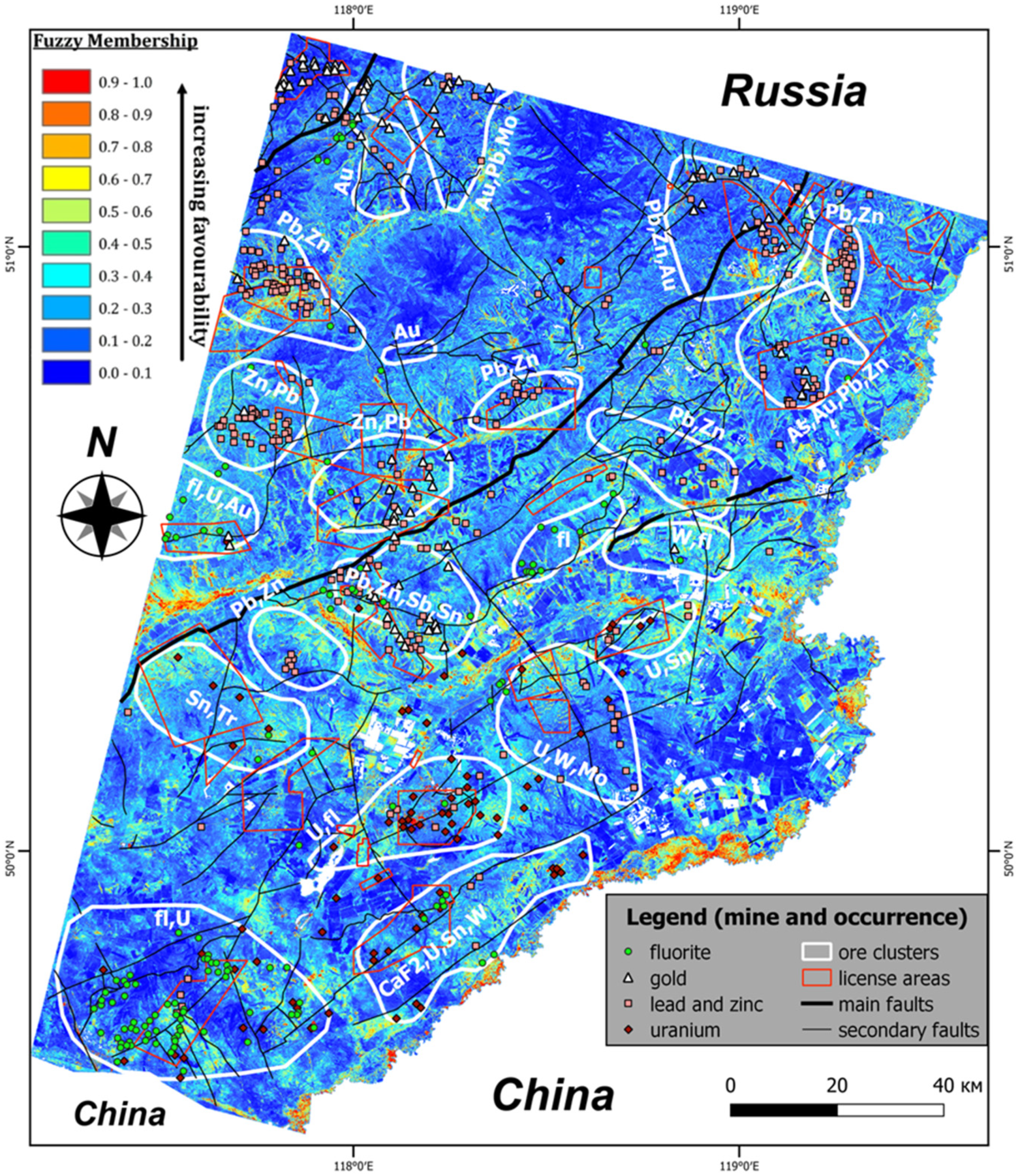
| Eigenvectors | Band 1 | Band 2 | Band 3 | Band 4 | Band 5 | Band 6 | Band 7 |
|---|---|---|---|---|---|---|---|
| PC1 | −0.0495 | −0.0650 | −0.1497 | −0.2377 | −0.4534 | −0.6808 | −0.4953 |
| PC2 | 0.4064 | 0.4415 | 0.4805 | 0.4465 | 0.0958 | −0.0443 | 0.0636 |
| PC3 | −0.1689 | −0.1306 | −0.0420 | 0.0887 | 0.8011 | −0.1440 | −0.5313 |
| PC4 | −0.1444 | −0.2034 | −0.1624 | −0.2091 | 0.3025 | −0.5585 | 0.6814 |
| PC5 | 0.5881 | 0.3506 | −0.1666 | −0.6658 | 0.2266 | 0.0788 | −0.0507 |
| PC6 | 0.5190 | −0.2626 | −0.6596 | 0.4748 | −0.0200 | −0.0258 | 0.0079 |
| PC7 | 0.4096 | −0.7420 | 0.5057 | −0.1544 | −0.0130 | 0.0207 | −0.0388 |
| Eigenvectors | Band 1 | Band 2 | Band 3 | Band 4 | Band 5 | Band 6 | Band 7 |
|---|---|---|---|---|---|---|---|
| PC1 | −0.0824 | −0.1040 | −0.1910 | −0.2730 | −0.4650 | −0.6520 | −0.4800 |
| PC2 | 0.2390 | 0.2730 | 0.3450 | 0.4040 | 0.5100 | −0.0455 | −0.3440 |
| PC3 | 0.3680 | 0.3430 | 0.3500 | 0.2260 | −0.6300 | −0.1410 | 0.3960 |
| PC4 | 0.2160 | 0.1880 | 0.0786 | 0.0844 | −0.2680 | 0.5880 | −0.6970 |
| PC5 | 0.5890 | 0.3820 | −0.2830 | −0.6080 | 0.2290 | −0.0178 | 0.0768 |
| PC6 | −0.4570 | 0.3190 | 0.6370 | −0.5290 | 0.0414 | 0.0363 | −0.0330 |
| PC7 | 0.4450 | −0.7170 | 0.4800 | −0.2350 | 0.0311 | 0.0154 | −0.0291 |
| Source Data | Input Layers | Detection Group | Membership Function | Fuzzy Type |
|---|---|---|---|---|
| Landsat-8 dataset (VNIR-SWIR) | PC4 | Hydroxyl-bearing minerals and carbonates | Linear | And |
| MNF4 | ||||
| IC2 | ||||
| PC5 | Iron oxide/hydroxide minerals | |||
| MNF5 | ||||
| IC3 | ||||
| PC3 | Geobotanic anomaly and ferrous iron minerals | |||
| MNF3 | ||||
| IC5 |
| № | Geomorphological Position | Quaternary Deposits | Composition of Prequaternary Rocks | Zone of Secondary Alteration |
|---|---|---|---|---|
| 1. | Medium- and low-mountain, weakly and strongly dissected steeply sloping relief. Landscape is more geochemically unstable. | Eluvial, desertion, colluvial, deluvial-colluvial. | Granites, granosyenites, granodiorites, monzodiorites, plagiogranites, diorites, monzonites, gabbro, gabbrodiorites, conglomerates, gravelites, sandstones, siltstones, mudstone interbeds, tuff, tuff sandstones. | K-feldspathization, beresitization. |
| 2. | Medium- and low-mountain, weakly and strongly dissected steeply sloping relief. The landscape is more geochemically unstable. | Eluvial, deluvial-solifluction, colluvial, deluvial-colluvial, alluvial-deluvial. | Granites, granodiorites, granosyenites, monzodiorites, diorites, plagiogranites, gabbro, gabbrodiorites, conglomerates, gravelites, shales, dolomites, limestones, sandstones, metabasalts, metarhyolites, tuffs. | K-feldspathization, beresitization, skarns, greisenization. |
| 3. | Erosion-denudation medium–low-mountain dissected steep-middle slope relief. The landscape is geochemically unstable. | Desertion, deluvial-colluvial, deluvial-proluvial, alluvial-deluvial. | Granites, granodiorites, granosyenites, monzodiorites, diorites, plagiogranites, gabbro, gabbrodiorites, rhyolites, rhyodacites, graniteporphyries, conglomerates, gravelites, marls, sandstones, limestones, mudstones, siltstones, tuffs. | Not defined (not identified). |
| 4. | Medium–low-mountainous, intensively and slightly dissected relief. The landscape is geochemically unstable. | Eluvial, desertion, colluvial, deluvial-colluvial. | Granites, granodiorites, granosyenites, monzodiorites, monocytes, diorites, gabbro, gabbrodiorites, rhyolites, shales, conglomerates. | Skarns, beresitization. |
| 5. | Erosion-denudation medium–low-mountain dissected steeply-medium slope relief. The landscape is geochemically stable. | Eluvial, desertion, colluvial, deluvial-colluvial. | Granites, granodiorites, granosyenites, monzodiorites, monocytes, diorites, gabbro, gabbrodiorites, plagiogranities. | Not defined (not identified). |
| 6. | Erosion-denudation medium–low-mountain dissected steep-medium slope relief. The landscape is geochemically stable. | Eluvial, desertion, colluvial. | Granites, granodiorites, granosyenites, monzodiorites, monocytes, diorites, gabbro, gabbrodiorites, plagiogranites. | Not defined (not identified). |
| 7. | Medium–low-mountain, intensely and slightly dissected relief. Landscape is geochemically unstable. | Eluvial, desertion, deluvial-colluvial. | Granites, granodiorites, granosyenites, monzodiorites, diorites, gabbro, gabbrodiorites, shales, siltstones, sandstones. | Argillization, quartz-fluorite veins. |
| 8. | Low-mountain moderately dissected relief. Landscape with high geochemical stability. | Deluvial-colluvial, deluvial-solifluction, alluvial-deluvial, alluvial. | Granites, granosyenites, granodiorites, monzodiorites, diorites, gabbro-diorities, syenites, conglomerates, gravelites, sandstones, siltstones, tuffs gravelstones, shales, metabasalts, trachybasalts, dolomites, limestones. | Argilization. |
| 9. | Medium–low-mountain dissected relief. Landscape is geochemically stable. | Eluvial, deluvial-colluvial, deluvial-solifluction, alluvial-deluvial. | Grannites, granodiorites, granosyenites, monzodiorites, diorites, plagiogranites, gabbro, gabbrodiorites, rhyolites, rhyodacites, shales, sieltstones, sandstones, gravelites, metabasalts, metarhyolites, trachyandesites, trachybasalts, metarhyolites, conglomerates, tuffs, interlayers of dolomites, limestones. | Silicification, tourmaline. |
| 10. | Low-mountain medium dissected relief. Landscape is with high geochemical stability. | Deluvial-colluvial, deluvial-solifluction, alluvial-deluvial, alluvial. | Grannites, granosyenites, gneiss-granites, trachybasalts, andesites, trachyandesites, shales, sandstones, gravelstones, dolomites, limestones, tuffs, tuff sandstones. | Argillization, silicification, tourmalinization, greisenization are common. |
| 11. | Low-mountain medium dissected relief. Landscape with high geochemical stability. | Deluvial-colluvial, deluvial-solifluction, alluvial-deluvial. | Grannites, granodiorites, granosyenites, gneiss-granites, blastocataclasites, blastomylonites, orthogneisses, gneisses, shales, limestones, dolomites, sandstones, siltstones, shale, gravelites, conglomerates, tuffs, tuff sandstones, tuff breccias. | Greisenization is widespread. |
| 12. | Structure-denudation and denudation medium–low mountain strongly partitioned relief. Landscape is geochemically sustainable. | Eluvial, desertion, deluvial-solifluctional, colluvial, deluvial-colluvial, deluvial-proluvial, alluvial-deluvial, alluvial. | Grannites, granodiorites, granosyenites, monzodiorites, diorites, gabbro, gabbrodiorites, leukogranites, conglomarates, shale, aleurolites, sandstones, gravelites, metabasaltes, metariolites, dolomite layer, limestones. | Argilization, silicification, tourmalinization. |
| 13. | Erosion-denudation low-mountain moderately partitioned and denudation low-mountain–hilly terrain. Landscape is geochemically sustainable. | Desertion, deluvial-solifluctional, deluvial, deluvial-colluvial, alluvial-deluvial, alluvial. | Grannites, granosyenites, granodiorites, monzodiorites, diorites, gabbro-diorites, trachybasalts andesites, sandstones rhyolites, dacites, shale, aleurolites, sandstones, gravelites, conglomerates, metabasaltes, metariolites, tuffs, dolomite layer, limestones, argillites. | Not defined (not identified). |
| 14. | Low-mountain dissected and accumulative moderately and slightly dissected hilly–ridged ridge relief. Landscape is geochemically sustainable. | Eluvial and deluvial, deluvia colluvial, alluvial-deluvial, alluvial. | Grannites, leucocratic grannites, granosyenites, gneissic granites, rhyolites, trachybasalts, basalts, basaltic andesites, andesites, dolomites, limestones, sandstones, siltstones, shales, gravelstones, conglomerates, tuffs, tuff sandstones. | Argillization and propilization are widely disseminated. |
| 15. | Low-mountain dissected and accumulative moderately and slightly dissected hilly–ridged ridge relief. Landscape is geochemically sustainable. | Eluvial and deluvial, deluvial, deluvial-colluvial, alluvial-deluvial, alluvial. | Grannites, granodiorites, granosyenites, monzodiorites, diorites, plagiogranites, gabbro, gabbrodiorities, rhyolites, granite-porphyry, gneiss-granites, shales, sandstones, gravelites, dolomite layers, limestones. | Occultation, kaolinization, Greysenization, quartz sericite metasomatites. |
| 16. | Low-mountain moderately dissected, medium-slope relief. Landscape with high and medium geochemical stability. | Deluvial, deluvial-colluvial, alluvial-deluvial, alluvial. | Leukogranites, granosienites, gneiss-granites, trachibaslts, basalts, andesiazalts, trachyancides, tuffs, granodiorites, monzodiorites, diorites, plagiogranities, gabbros, gabbrodierites, blactocataclasites, orthogneisses, gneisses, plagiogneisses, shales, quartzites, marbles, limestones, dolomites, amphiboles, dacites, riodacites, trachiriodacites, trachyrolites, granodiorities-porphyries, granosienite-porphyries, andesites; trachiandesites, trachiandasites. | Argillization, occultation, tourmalinization, squaring, greisenization, muscovitization. |
| Covariance | PC1 | PC2 | PC3 | PC4 | PC5 | PC6 | PC7 |
|---|---|---|---|---|---|---|---|
| IC1 | 3.67 × 10−2 | 2.03 × 10−12 | −1.73 × 10−12 | −5.69 × 10−13 | 1.12 × 10−13 | −1.70 × 10−13 | −2.42 × 10−14 |
| IC2 | 2.03 × 10−12 | 3.28 × 10−4 | −4.89 × 10−14 | −2.72 × 10−14 | 6.67 × 10−15 | −6.43 × 10−15 | −3.86 × 10−15 |
| IC3 | −1.73 × 10−12 | −4.89 × 10−14 | 1.91 × 10−4 | 7.73 × 10−15 | −2.65 × 10−15 | 1.84 × 10−15 | 1.36 × 10−15 |
| IC4 | −5.69 × 10−13 | −2.72 × 10−14 | 7.73 × 10−15 | 2.85 × 10−5 | −1.14 × 10−15 | 1.09 × 10−15 | 6.63 × 10−16 |
| IC5 | 1.12 × 10−13 | 6.67 × 10−15 | −2.65 × 10−15 | −1.14 × 10−15 | 1.25 × 10−5 | −3.63 × 10−16 | −9.34 × 10−17 |
| IC6 | −1.70 × 10−13 | −6.43 × 10−15 | 1.84 × 10−15 | 1.09 × 10−15 | −3.63 × 10−16 | 1.62 × 10−6 | 1.69 × 10−16 |
| IC7 | −2.42 × 10−14 | −3.86 × 10−15 | 1.36 × 10−15 | 6.63 × 10−16 | −9.34 × 10−17 | 1.69 × 10−16 | 9.44 × 10−7 |
| Correlation | PC1 | PC2 | PC3 | PC4 | PC5 | PC6 | PC7 |
|---|---|---|---|---|---|---|---|
| IC1 | 1.00 × 100 | 5.84 × 10−10 | −6.53 × 10−10 | −5.57 × 10−10 | 1.66 × 10−10 | −6.95 × 10−10 | −1.30 × 10−10 |
| IC2 | 5.84 × 10−10 | 1.00 × 100 | −1.95 × 10−10 | −2.82 × 10−10 | 1.04 × 10−10 | −2.78 × 10−10 | −2.19 × 10−10 |
| IC3 | −6.53 × 10−10 | −1.95 × 10−10 | 1.00 × 100 | 1.05 × 10−10 | −5.42 × 10−11 | 1.04 × 10−10 | 1.02 × 10−10 |
| IC4 | −5.57 × 10−10 | −2.82 × 10−10 | 1.05 × 10−10 | 1.00 × 100 | −6.03 × 10−11 | 1.60 × 10−10 | 1.28 × 10−10 |
| IC5 | 1.66 × 10−10 | 1.04 × 10−10 | −5.42 × 10−11 | −6.03 × 10−11 | 1.00 × 100 | −8.06 × 10−11 | −2.72 × 10−11 |
| IC6 | −6.95 × 10−10 | −2.78 × 10−10 | 1.04 × 10−10 | 1.60 × 10−10 | −8.06 × 10−11 | 1.00 × 100 | 1.36 × 10−10 |
| IC7 | −1.30 × 10−10 | −2.19 × 10−10 | 1.02 × 10−10 | 1.28 × 10−10 | −2.72 × 10−11 | 1.36 × 10−10 | 1.00 × 100 |
Publisher’s Note: MDPI stays neutral with regard to jurisdictional claims in published maps and institutional affiliations. |
© 2022 by the authors. Licensee MDPI, Basel, Switzerland. This article is an open access article distributed under the terms and conditions of the Creative Commons Attribution (CC BY) license (https://creativecommons.org/licenses/by/4.0/).
Share and Cite
Nafigin, I.O.; Ishmukhametova, V.T.; Ustinov, S.A.; Minaev, V.A.; Petrov, V.A. Geological and Mineralogical Mapping Based on Statistical Methods of Remote Sensing Data Processing of Landsat-8: A Case Study in the Southeastern Transbaikalia, Russia. Sustainability 2022, 14, 9242. https://doi.org/10.3390/su14159242
Nafigin IO, Ishmukhametova VT, Ustinov SA, Minaev VA, Petrov VA. Geological and Mineralogical Mapping Based on Statistical Methods of Remote Sensing Data Processing of Landsat-8: A Case Study in the Southeastern Transbaikalia, Russia. Sustainability. 2022; 14(15):9242. https://doi.org/10.3390/su14159242
Chicago/Turabian StyleNafigin, Igor Olegovich, Venera Talgatovna Ishmukhametova, Stepan Andreevich Ustinov, Vasily Alexandrovich Minaev, and Vladislav Alexandrovich Petrov. 2022. "Geological and Mineralogical Mapping Based on Statistical Methods of Remote Sensing Data Processing of Landsat-8: A Case Study in the Southeastern Transbaikalia, Russia" Sustainability 14, no. 15: 9242. https://doi.org/10.3390/su14159242
APA StyleNafigin, I. O., Ishmukhametova, V. T., Ustinov, S. A., Minaev, V. A., & Petrov, V. A. (2022). Geological and Mineralogical Mapping Based on Statistical Methods of Remote Sensing Data Processing of Landsat-8: A Case Study in the Southeastern Transbaikalia, Russia. Sustainability, 14(15), 9242. https://doi.org/10.3390/su14159242






